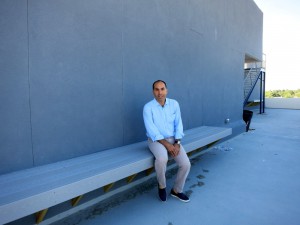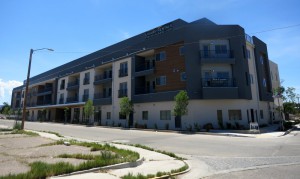By Leah Etling on September 8, 2015 in News
ALBUQUERQUE, NM – The Platinum is not your typical Albuquerque apartment complex.

It is four stories, expected to be LEED-Platinum certified, with city and mountain views: in other words, a modern marvel that will draw some of the city’s highest rents. It’s surrounded by Nob Hill, Albuquerque’s most walkable urban neighborhood. The area is a mix of higher education, restaurants and service businesses along Central Ave., also known as historic Route 66.
“This is Albuquerque’s main street,” says Rick Goldman, developer of The Platinum and two other nearby condo and loft projects. “Usually, retail follows rooftops. But in this town, you had retail on Central, but no rooftops to speak of.” Albuquerque has sprawling single family housing tracts spread across the city. High density apartments rising above two stories tall are rare.
Your typical Albuquerque apartment complex, says longtime broker Todd Clark, “was built in 1970, is two-story, brick, with a pitched roof, master-metered and originally offered furnished. It’s an island surrounded by a sea of parking.”
So is the Platinum a symbol of things to come in New Mexico? Maybe. But there are challenges ahead before Albuquerque can be considered a transit-friendly, walkable urban destination.
Breweries and buses
How can you tell when a city is poised for an influx of millennials? CBRE’s Billy Eagle, who specializes in multifamily sales, suggests that you might want to track brewery openings.
“During the last two or three years we’ve seen the breweries expand five-fold. I think there are now more than 25 in town,” says Eagle, who relocated to Albuquerque from Southern California eight years ago, when he was in his early 20’s. He talks enthusiastically about cycling around downtown, weekly farmer’s markets, new restaurant openings and Uber: all hot with Millennials.
During his time in New Mexico, Eagle experienced the major economic slowdown that hit hard here starting in 2009-2010, and has only recently shown signs of recovery. Real estate deals, including sales of multifamily product, are increasing; job growth is slowly happening; and rent growth has picked up to around 2 percent, according to a CBRE market survey.
But two things are missing before Albuquerque can truly claim to be booming, Eagle says: usable, quality office space in the city’s downtown, and better transit networks.
“Most of the Class A office space downtown is leased,” Eagle says. “And there are very low overall occupancy rates there, because the C product available needs to be redeveloped.”
Transit is an issue that’s closer to being solved. The city is working on an improved Albuquerque Rapid Transit line that would connect Nob Hill with the downtown core, and express bus lines are already in place along Central to move people quickly from one part of town to another. Cycling is on the upswing, and the Railrunner, a regional train, takes commuters from Albuquerque to Santa Fe and back again.
Longtime local perspectives
Developer David Silverman grew up in New Mexico, left for college, and came back 10 years later. His family’s company, Geltmore LLC, has projects around New Mexico and Texas. Currently under construction is a downtown Albuquerque grocery story on the ground floor of the Imperial Building, located at 205 Silver Ave. SW. Three stories of affordable housing are rising above the retail.
“Currently, there’s no services downtown. But the grocery store opening in April (2016) will solve that problem. It’s going to take some time for people to understand that they can live downtown and not rely on their car every day,” Silverman said. He agrees with Eagle that the vacant Class C office space downtown is among the biggest roadblocks to a thriving Albuquerque.
While staying optimistic about the city’s future, Silverman is adamant that his own Millennial generation can’t be its only salvation. “We need to see the private sector job base grow significantly,” he says. “It’s not a millennial solution. It’s a people solution.”
Clarke, one of the city’s most-quoted boosters, has a different perspective. A fourth generation New Mexican, he’s adamant that Millennials are Albuquerque’s best bet, and that if you build walkable urban housing, they will come.
‘We think there are about 17,000 units of (local apartment) demand, just from Millennials,” said Clarke, who compiles his own database on multifamily transactions. New Mexico is one of four of the nation’s non-disclosure states, making obtaining transactional details a challenge.
Pushing a unique product

Back on the Platinum rooftop, Rick Goldman is talking about risk. Is he taking one by asking $1900 for a two bedroom, fourth floor apartment? It’s got great views of Sandia Peak and the Nob Hill neighborhood down below looks like Lego toys – simple, single story square blocks.
That price will also rent you a four-bedroom, 3,000sf single family home in the Albuquerque suburbs. But Goldman, principal of Chicago-based Golden Spike Development, doesn’t think there’s any chance the Platinum units will be vacant for long.
“We don’t believe it’s that much of a risk. We’re not trying to invent customers, or a community. We feel we’re providing for an underserved clientele that already exists,” Goldman says. He points to the rooftop views, on site yoga studio, electric car charging station and dog washing room as lifestyle amenities that don’t exist at other properties.
His architect, Stace McGee of Environmental Dynamics, calls Goldman fearless.
“This is a developer from out of town, who has led the way and done the work. He’s shown the community that there was a pent up demand for high quality housing of all different styles. And he’s pushed the envelope all the way.”


